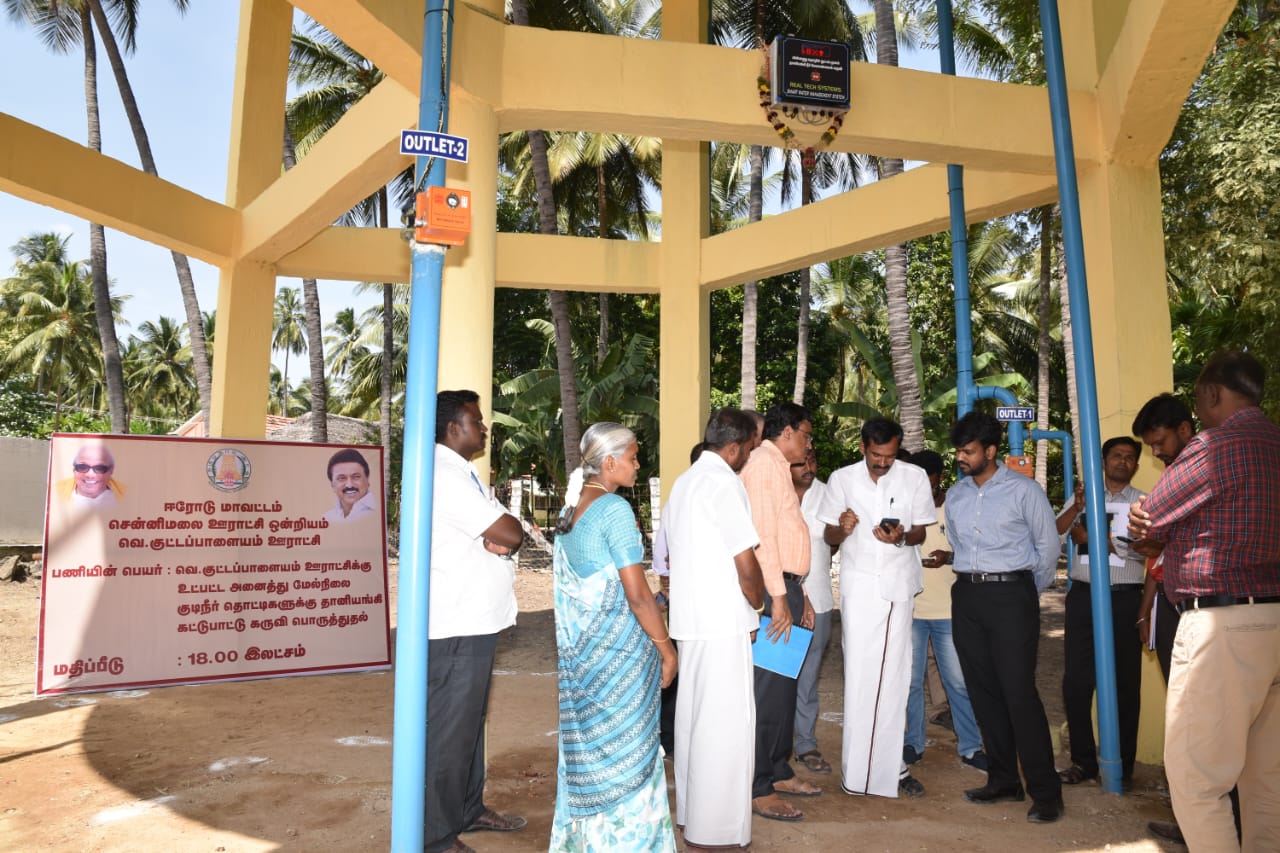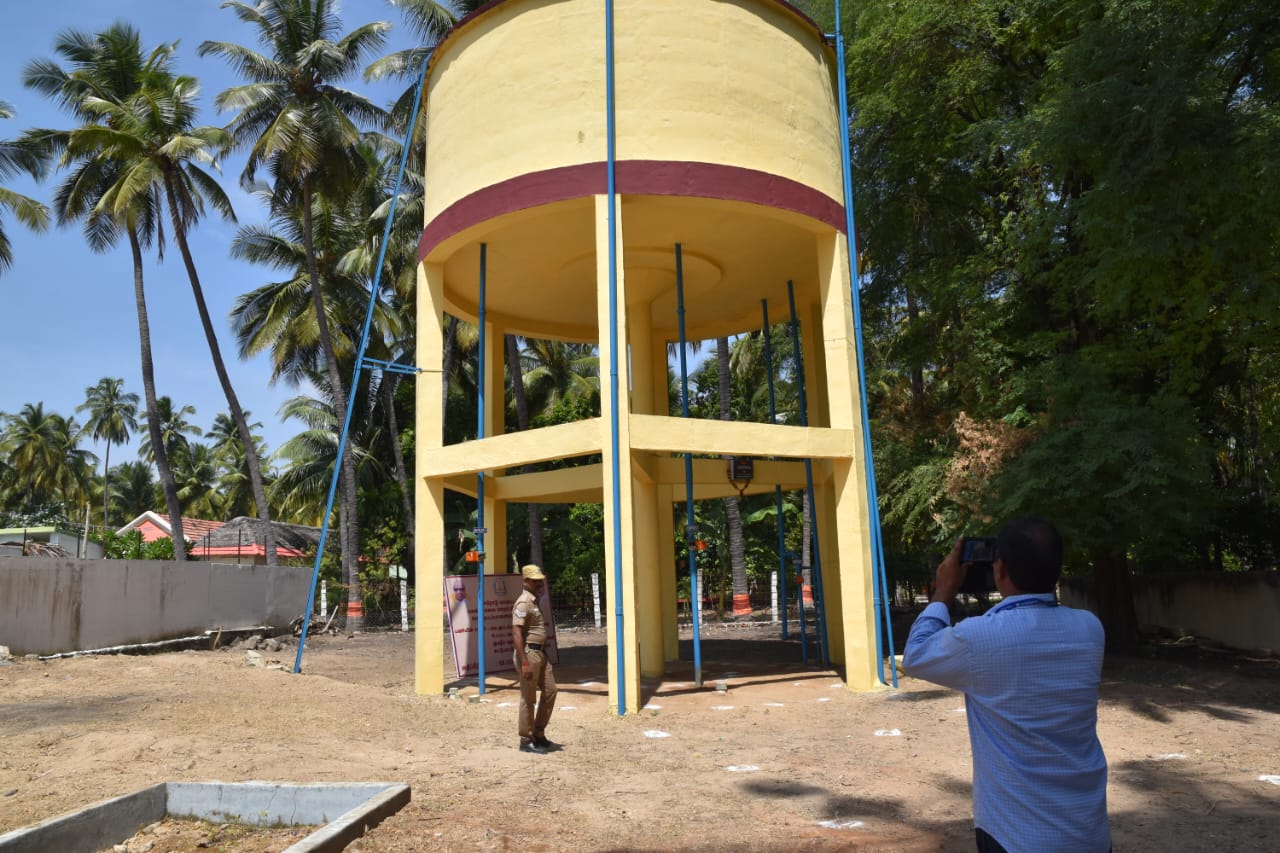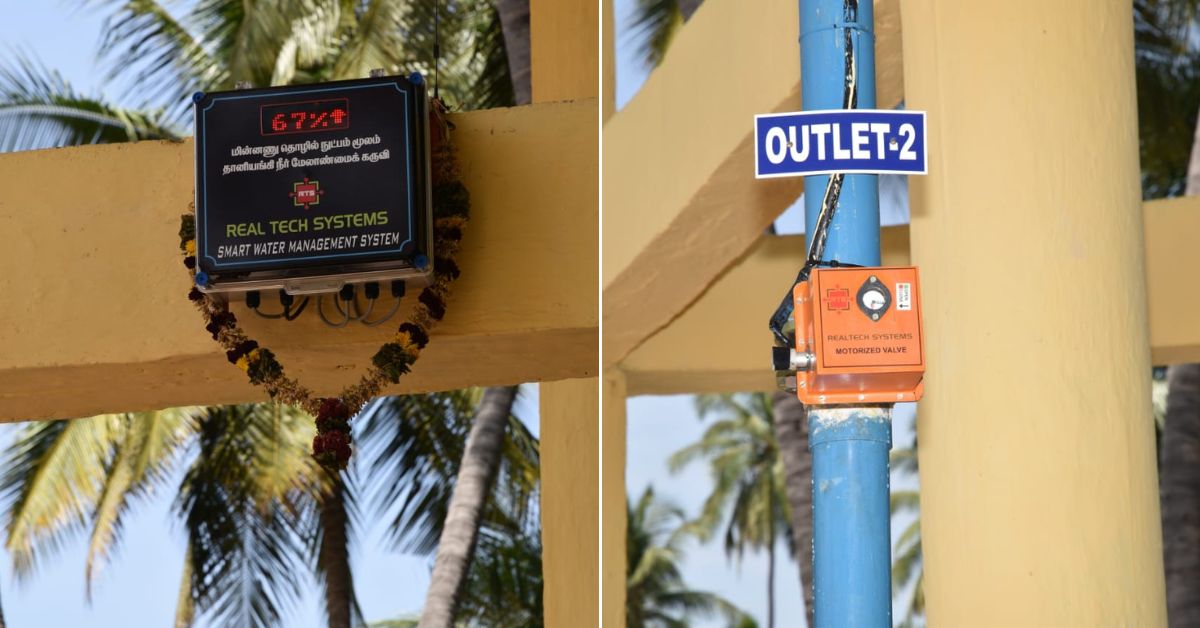Erode district, which lies in the western part of Tamil Nadu, is a region characterised by limited rainfall, dry climate and erratic water supply. For the approximately 11 lakh residents of the district who reside in its rural areas (as per 2011 Census), this irregular water supply is an even bigger concern.
According to the district administration, while the rural water demand in the district is 74 MLD (million litres a day), the water supplied is approximately 40 to 55 LPCD (litres per capita per day).
“This water is supplied from the Kaveri and Bhavani rivers through 20 Combined Water Supply Schemes (i.e. water from rivers) apart from local borewell sources. Currently, most villages in Erode district and elsewhere rely on overhead tanks (OHTs) for their water supply, sourced either from borewells or infiltration wells in nearby rivers,” explains District Collector (DC) Raja Gopal Sunkara, a 2015-batch IAS officer, in a conversation with The Better India.
DC Sunkara goes on to explain that in the Erode district, there are over 4,700 Over Head Tanks (OHTs) in rural areas whereas the number of tank operators is only 299.
Due to the reliance on tank operators, he explains the following problems were being faced:
1) High water losses: “In most villages, we see overflowing OHTs since the motors are not switched off on time,” explains DC Sunkara.
2) Unreliable timings of water supply: Since tank operators have to manually manage OHTs, water supply timings change from day to day depending on their availability and punctuality.
3) High electricity bill for the local body: “Since the motors are not switched off on time, the electricity bills of villages increase,” he notes.
4) Dry Run: Motors get damaged when they are run without water in the sump.
As K Renuva Devi, the Panchayat president of Kuttapalayam village explains, “Earlier, we were dependent on the tank operator, who used to manually operate the gate valves and motor pumps. There used to be overflow from the tanks.”
To address these failings of the OHT water supply system in Erode district, DC Sunkara has installed IoT devices in 50 habitations across 16 villages, which the district administration claims have not only reduced electricity bills by approximately 40% but also increased water supply by over 20%.

Finding IoT solutions
Before his current posting as DC of Erode in May 2023, DC Sunkara — a dual-degree holder from IIT-Kharagpur — worked as a commissioner in the neighbouring Coimbatore city municipal corporation where a 24/7 water supply scheme was being implemented, and as executive director of the Chennai Metropolitan Water Supply and Sewerage Board (CMWSSB).
In both these roles, he got a deeper understanding of water supply systems, but predominantly in urban settings. “Following my posting in Erode, I organised regular inspections to garner a greater understanding of the scale of the rural water distribution problem,” he notes.
To tackle these issues, the administration installed IoT devices with the following features:
1. Tank-level alerts providing real-time updates on water levels in the sumps and the OHT.
2. Automated pumping: As per this system, water is automatically pumped to the OHT from the sump, with a semi-automatic option for special occasions.
3. Scheduled water supply: Timings can be preset and valves open automatically.
4. Overflow Prevention: Installation of automatic mechanisms to stop overflow.
5. Comprehensive data on water quantity and timings, enhancing accountability.
According to DC Sunkara, “This IoT system has already been successfully implemented in 63 OHTs in 50 habitations in Erode district, resulting in significant benefits — such as reduced motor running time, lower electricity bills, and minimised water wastage. More importantly, the reliability of water supply to the public has seen a remarkable improvement; thus alleviating the burden on women who often spend considerable time waiting near taps.”
“The initiative costs roughly Rs 1 to 1.5 lakh per OHT, and has been mostly taken up under the village panchayat general fund or 15th Central Finance Commission (CFC) funds. After the initial successes, we are working on installing it in 150 OHTs in Har Ghar Jal villages (all households in that village are provided with tap water supply) using these funds along with the District Mineral Foundation funds, Corporate Environment Responsibility funds, etc,” he adds.

How does this technology work?
“A linear level sensor pushes tank level alerts to the IoT Master Controller, triggering the pump and inlet valve to ensure OHT filling when water levels are low,” explains DC Sunkara.
Once the required level is reached, the motor switches off, and the inlet valve closes. The outlet valve operates automatically based on pre-set schedules. Real-time data generated from these functions is stored in AWS Cloud and can be accessed through the iNeer mobile app by stakeholders.
“Comprehensive data on water quantity and timings are collected in real-time through the sensors, which is made available on a mobile application to local public representatives like Panchayat presidents, tank operators, councillors, etc. The mobile application called iNeer, (available on Google Play Store) provides insights into consumption patterns and operational efficiency,” he says.
“Based on feedback from the stakeholders, the mobile application has been redesigned to make it very user-friendly. The impact on residents is reflected in improved water availability, reliable water timings, reduced waiting time, better water pressure and overall convenience,” he adds.
To make sure this system works, DC Sunkara notes how pilots were taken up in Kumaravalasu, Kuttapalayam and Ponmudi village panchayats under the leadership of Panchayat presidents.
“The initial findings of these pilots were very encouraging,” he shares. But the administration did encounter challenges during the pilot/testing process including technical glitches and ensuring compatibility with existing infrastructure.
“During the pilot stage, we planned for an electricity board (EB) supply for the IoT controllers and motorised valves. The controllers had to be chosen accordingly. The controllers got damaged during voltage fluctuations and lightning events. We then introduced a solar power supply with battery backup. The specifications for wattage, etc were finalised after a lot of trial and error,” he explains, adding, “At each stage, it was a learning process for us.”
Other implementation challenges included maintenance issues and the need for continuous monitoring, requiring collaboration with tech experts and regular training for maintenance staff.
Meanwhile, public representatives like Panchayat presidents and Councillors were also trained in using the app through which OHTs can be controlled and data can be seen. Suffice it to say, there was some scepticism about the implementation of these IoT devices.
“Initial scepticism was due to the cost of the technology and since there was no precedent to learn from. While Panchayat presidents of the pilot villages took on this experiment with open minds, the other presidents were brought on board by arranging visits to see the success of the initiative in pilot villages. This helped overcome this scepticism,” he adds.

Benefits to Rural Erode
How have these systems benefitted residents in terms of reduced motor running time, lower electricity bills, minimising water wastage and reliable water supply?
In Ponmudi village, for example, the IoT system was installed in 10 OHTs.
According to DC Sunkara, “The electricity units consumed fell from 35,930 (4 months before installation) to 17,819 (4 months post-installation) — a drastic 50% decrease. The electricity bill fell from Rs 2,72,707 to Rs 1,67,001 for the same period — a 40% fall. Meanwhile, the quantity of water supplied per day increased from 1.65 lakh litres to 2.09 lakh litres — additional supply of 44,180 litres. These savings can be used for providing other amenities to the public. The results for Ponmudi have been reflected in other villages too.”
As Renuva Devi, Panchayat president of Kuttapalayam village also notes, “Now, we are not dependent on the tank operator. Water is automatically supplied to the public at pre-set timings. There have hardly been any complaints regarding water supply from the public. Fixed quantity is being supplied for a fixed timing and then, there are water savings.”
These systems also helped alleviate the burden on women — particularly from households with no direct water supply connections who often spend a long time waiting near taps.
“In our society, the burden of fetching water falls on women. Water is supplied through household connections or public fountains in rural areas. Those who don’t have these connections or who are not getting adequate quantities of water through such connections were either forced to purchase water in the private market or wait at public fountains. The burden on women was further aggravated because of unreliable water supply timings. They would have to wait at odd timings and for long periods for water,” informs DC Sunkara.
He further explains, “Out of 4,18,981 households, 3,56,101 have connections under the Jal Jeevan Mission, and works are ongoing for giving functional household tap connections to all.”

Kalaiselvi, a 32-year-old resident of Ponmudi village, notes, “Earlier, water supply in our village was problematic. It was managed by a waterman (tank operator). He would switch on the motor pump to the overhead tanks and forget to switch it off. We would have to call and remind him, and only then would he switch off the motor. There was a lot of water wastage due to this.”
“Despite tap connections being affected to all households under the Jal Jeevan Mission, we never knew when water would be supplied. Most of the women in the village go to work. On days when water is supplied, they would have to take leave or not be able to fetch water. Moreover, houses at a higher elevation used to get less water and those at a lower elevation used to get more water,” she adds.
“Now, a fixed quantity of water is being supplied at pre-set timings, irrespective of elevation. Today, our area gets water from 6 am to 8 am every day. A WhatsApp group has been created in which water supply timings are informed to us. Water wastage and electricity bills also have come down. We are not forced to take leave [from work] for fetching water,” says Kalaiselvi.
Moving forward, the plan is to install these IoT devices in OHTs located in other villages too. “Our vision is to harness available technology and expand this initiative, one village at a time, utilising existing funds,” says DC Sunkara.
(Edited by Pranita Bhat; Images courtesy Erode District Administration)
No comments:
Post a Comment